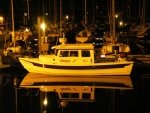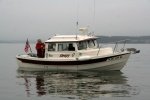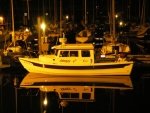I just got my Weems and Plath distress signal sent out by Captains Nautical. I was going to fire it up, but I don’t have any C type batteries at home. I have a dozen at the shop, and I know that they are less than a year old, but that brings up an issue. The directions say to change the batteries annually, so I have a 6 year supply of batteries, right? You can see the issue. How old can the batteries be, even if changed annually, and still meet the CG requirement?
The CFR is silent. Most C batteries have an expiration date, which is generally seen as a date when the manufacturer assumes the battery will be below 80% of manufacturing specs. For Duracell brand, that’s usually 10 years out. So the major benefit of changing batteries annually may be to check for corrosion.
The power requirement (46 CFR § 161.013-9) does not contain battery specifications, including anything about expiration dates. Odd that the flares have a date on them (as do most C batteries) and yet nothing about batteries is stated in the CFR. It does require a battery that can operate the light in SOS mode for 6 hours, but how is that tested? After all the requirements stated for flares, it seems that the light gets off “lightly.”
I bought one just to guarantee that I meet CG requirements, but I’ve had enough experiences with batteries to know that not all batteries are created equal. My latest experience was an enterprising business that “rebadged” inexpensive zinc/carbon batteries as rechargeable NiMH batteries and sold them on Ebay. I just happened to buy some and, when they quickly discharged and would not recharge, I did some Google research and found that the market had been temporarily flooded. Others had them pop open and ruin chargers. The labels were very professional and were actually a copy of a legitimate rechargeable battery but were covering up the original label (all in Chinese). So I need to make sure (somehow) that the batteries in my safety equipment are “legitimate.”
There is also the issue of amp hours. Alkaline C batteries can hold up to 7,800 mAh, rechargeable NiMH can hold up to 6,000 mAh, and zinc/carbon usually hold up to 2,200 mAh. Presumably, all zinc carbon batteries (when new) meet the CG 6 hour operating time, but there are choices. We have had the same alkaline batteries in our ACR Fireflys for years. They still work, but after thinking about it, it is time for an "annual" change.
The SOS pattern is actually part of the USCG light requirement. As has been pointed out, I also think the SOS idea is outdated. It was a wonderful thing in 1838 when a ship could use its whale oil semaphore lantern to signal to shore that it was in distress. It was still a good idea in 1938 when every Boy Scout learned it (and good flashlights even had a special Morse code button). It won’t mean anything by 2038.
Besides the outmoded use of Morse code, it makes little sense on a light that might be floating on the water surface. What would it look like from any distance in a two foot chop. One long. Was that two shorts? Maybe that’s two longs? The “long and short” of it is don’t expect any assistance to result from this light when its floating.
A new pattern, possibly incorporating color changes, would be simple with LED technology. Maybe something like alternating red and white changing every .5 seconds. Something that would be uncommon (except on yachts with a disco deck). An alternating color change would be recognizable even if seen intermittently in rough seas.
A new signal protocol that is recognizable even from glimpses of a floating light would require a “retraining” of the public. Since only 15% of the public could now recognize a regular SOS, it may be time for a retraining anyway. Like that will ever happen.
Mark



